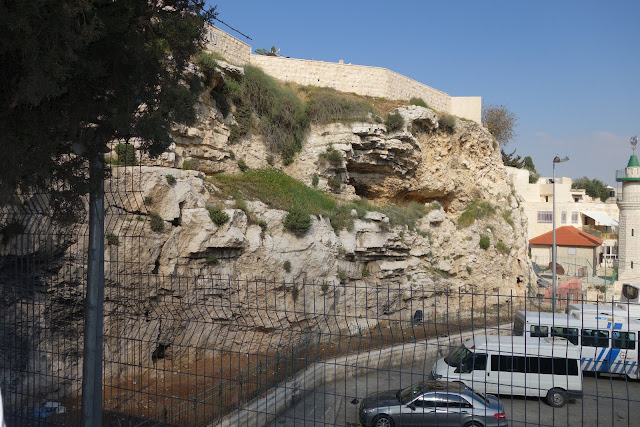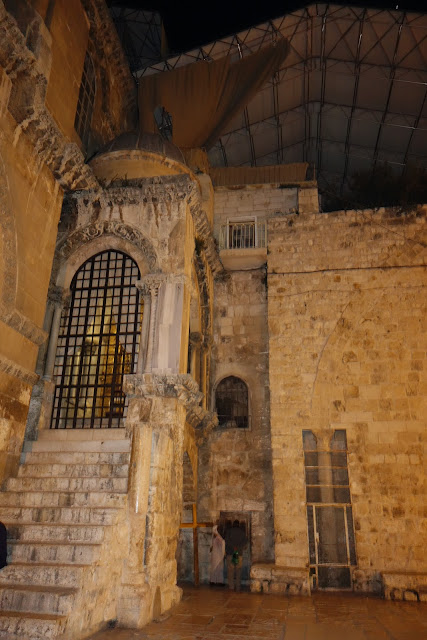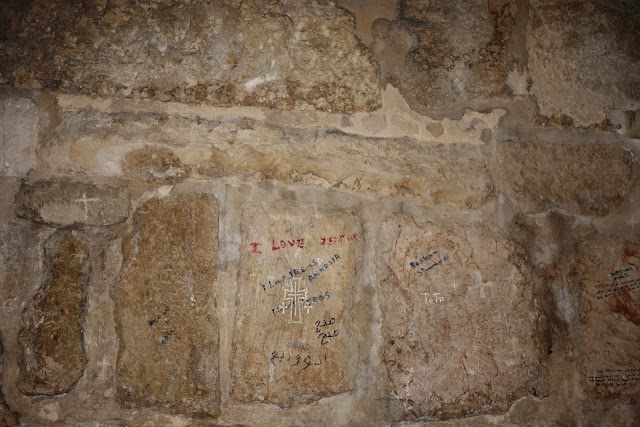Today was definitely one of those "I can't believe I'm here" days. It was a Saturday, the Jewish Sabbath. We started out at the Garden of Gethsemane.
This is the day I began to understand how near everything is. You can see the (golden) Dome of the Rock from here, and the nativity and crucifixion and tomb are all very likely in this area. The Mount of Olives and Gethsemane are here, too.
The Garden of Gethsemane is basically an olive grove
with the distinctive ancient, gnarled olives tree.
Of course, these trees don't date back to the time of Christ, but scientists have dated several of these trees back to dates ranging from 1092 AD-1198 AD. This makes these trees some of the oldest trees in the world. Likely, they are the offshoots of the original trees of Gethsemane.
I love these fascinating trucks.
Every garden needs a gate.
The Garden is relatively small, and part way up the hill.
Above the garden is Orson Hyde Memorial Park, which to my great disappointment, was not on our visit list. I guess you can't see everything in one visit.
Look at this great old tree, propped up by an olive wood crutch.
Russian Olive trees have become an invasive species in Billings--I wonder if these olives spread as easily.
It was a peaceful day, not too many people here yet.
Just beyond the garden was this interesting church--The Church of All Nations.
It is here that the rock Christ is recorded to have prayed on in the garden is believe to be. There was a service going on, so I didn't feel comfortable running up to take a picture, but it's in the front, where the priest in red is speaking.
This is a Catholic church, built upon an older church with funds donated by many countries. The
mosaic work in the church is fantastic.
I love the blue ceilings with gold embellishment.
The church is used by a number of churches besides Catholic, including Protestant, Anglican, Evangelical, Lutheran, and several others. I like that kind of religious co-operation.
The church was built around 1920.
The first church built on this spot was a Byzantine basilica, destroyed by an earthquake in 614 AD, according to the sign in the foyer (wikipedia has a different date of 746).
The next church was built over the old basilica by the Crusaders and abandoned in 1200 (1345 according to wikipedia).
These mosaics have a definite 20's feel to them--kind of art nouveau-ish. Maybe it's the colors?
Even the entrance was stunning.
The original mosaic floors (framed, under glass) from the Crusader era were discovered, and re-created by the 1920's architect.
I had to smile at this very, very sincere sign: ONLY CATHOLICS, and poor CATHOLICS at that, funded this place, not governments.
The exterior of this building was equally fabulous, with beautiful mosaic of Christ (center figure), acting as mediator between God and man.
Look at those columns--incredible!
I only wished I could have gotten a closer look at this mosaics, at least two stories above the ground.
Ruins of the former church can be found around the current church.
What a lovely church!
Our next stop was the place I'd always heard called the "BYU Center", but everyone here calls it "BYU University".
The church in Jerusalem recognizes Saturday as the Sabbath, as is traditional in this area, and we stopped for Sacrament meeting.
An interesting fountain.
Someone, I won't say who (but I'm married to him), kept taking pictures of things he wasn't suppose to. Apparently, his pictures of the Holy Sepulchre didn't turn out, but this view from the chapel at the BYU Center did. The view from our seats were breathtaking. I think every chapel needs a view like this--it would increase attendance ten times over.
A view of the grounds. There were a few security guards inside, monitoring comings and goings. They were pretty unintrusive. I didn't notice them till I'd passed them several times.
As I look through my pictures, it's amazing how much we saw on any given day. Our next stop was Mount Scopus area, the north-east ridge of Mount of Olives.
It's a great place to view the city, and was an important military lookout at various points in history.
To our right was this timeless picturesque scene of a shepherd with his flock.
On the other side of this mountain ridge is Bethany, home to Martha, Mary, and Lazarus.
I ate more lamb in Israel than I've eaten in the last fifty years of my live. I just hope I didn't dine on one of these fellas.
You can see the freeway in the bottom half of this picture. The ancient wall of Jerusalem ran along that road. You can still see parts of the original wall.
Not the most exciting job in the world--one hopes he remembered his kindle.
You can spot the golden Dome of the Rock on the right side, as well as the arched wall of the BYU Center near the center.
As you can see, the air is pretty smoggy.
A bus window shot of the BYU Center.
We passed Zion's Gate, with its bullet-ridden wall, courtesy of the conflict of 1948.
We headed to the Room of the Last Supper.
This hall was built in the Middle Ages, at the place, according to tradition, Jesus partook of the sacrament with his disciples, just before his crucifixion.
The inside was quite simple,
not particularly memorable, and I was soon distracted by a tourist group singing a hymn in another language.
We passed an orange tree, ready to be picked. This is actually the first orange tree I can remember ever seeing. I grew up in the land of cherries and peaches, but orange trees are not part of my experience.
From time to time, we caught glimpses of very crowded neighborhoods, like this particular view of Jerusalem. This is the Kidron valley, a prominent path of Jesus's time. I'm willing to bet it wasn't nearly this crowded then.
We travelled on to the church of St Peter in Gallicantu.
It is a Catholic church, built, of course on an old church like everything else in the area.
The original was a Byzantine shrine, followed by a Crusader chapel, destroyed in the 70 AD fall of Jerusalem, and finally rebuilt in current form in 1931.
This is the place Peter denied Christ three times,
as depicted in this statue showing Peter with the soldier
and two women, with the cock crowing on top.
Below the church are a number of cisterns, caves, and cellars, and, it is thought, possibly holding places for prisoners.
There is a stone stairway, dated to the days of Christ, which would have been the path the Savior took to the Mount of Olives.
It is also the path the soldiers would have taken Christ up to Caiaphas for his trial.
Looking down from the top of this stairway, you can see the Kidron valley.
Our final tour stop of the day (boy oh boy, did we fit a lot into a day) was the Garden Tomb
This is the Protestant site, and while it's probably a good representation of what the Savior's tomb may have looked like, there's no way to really know if this is "the" tomb.
It was one of the more crowded places we visited.
It was nicely landscaped, with paths leading from the proposed crucifixion site to the tomb.
A reminder of the troubles of Jerusalem.
We started at this spot, a possible site of Golgotha, now a parking lot.
Michael told us crucifixions generally took place down below as a reminder of the lowness of the person being crucified, and people on the road above would walk by and jeer and spit. Note the wall on top of the mountain--it's a Muslim cemetery.
This is the same spot years ago, when travel was done by camel instead of bus.
The line to the tomb was respectably long.
There was a small round stone on exhibit to give us an idea what the larger stone looked like. It was plenty heavy.
It's a little hard to see, but the rut the circular stone would have rolled on is still there.
Here is a helpful diagram of the tomb: two rooms, the first used for preparing the body, the second for burial.
This is the burial side. The mark on the wall is a Byzantine cross--the original is under it, covered with waxy plaster to protect it, and painted over with this one.
Floor of the tomb. The guide said there were originally ledges around this room.
As we exited, this is the door we passed through. That says it all.
We had a free evening and decided to return to the Church of the Holy Sepulchre.
I was struck by how many things I had missed the first time.
Inside the church is a basement that is a 12th century chapel, dedicated to St. Helena, mother of Constantine, responsible for finding and marking the location of many Biblical sites in Jerusalem.
This chapel included some restored mosaic floors.
They are beautiful.
There were frescoes preserved behind glass from Crusader days
complete with folded papers we concluded were prayers, left by worshippers.
I don't think love of Jesus gets you off the hook for defacing ancient places with graffiti.
This church, the Catholic's chosen spot of the burial, is about as opposite as possible from the Garden Tomb, but lovely and reverent in its own way.
Many of the walls were covered with these crosses. I either can't remember why, or I never found out. It seems to be some sort of recording of something.
Stairway down to St. Helena's chapel.
I missed this skull the first time
located on the mosaic near the entrance.
Our final stop of the day was to buy "good" baklava. This, sadly, was without a doubt not it. You'd think in a country famous for baklava, good stuff would be everywhere, but we never did find anything even moderately ok.




































































































Wow! This is my favorite day. Although, I keep saying that with each of your posts.
ReplyDelete